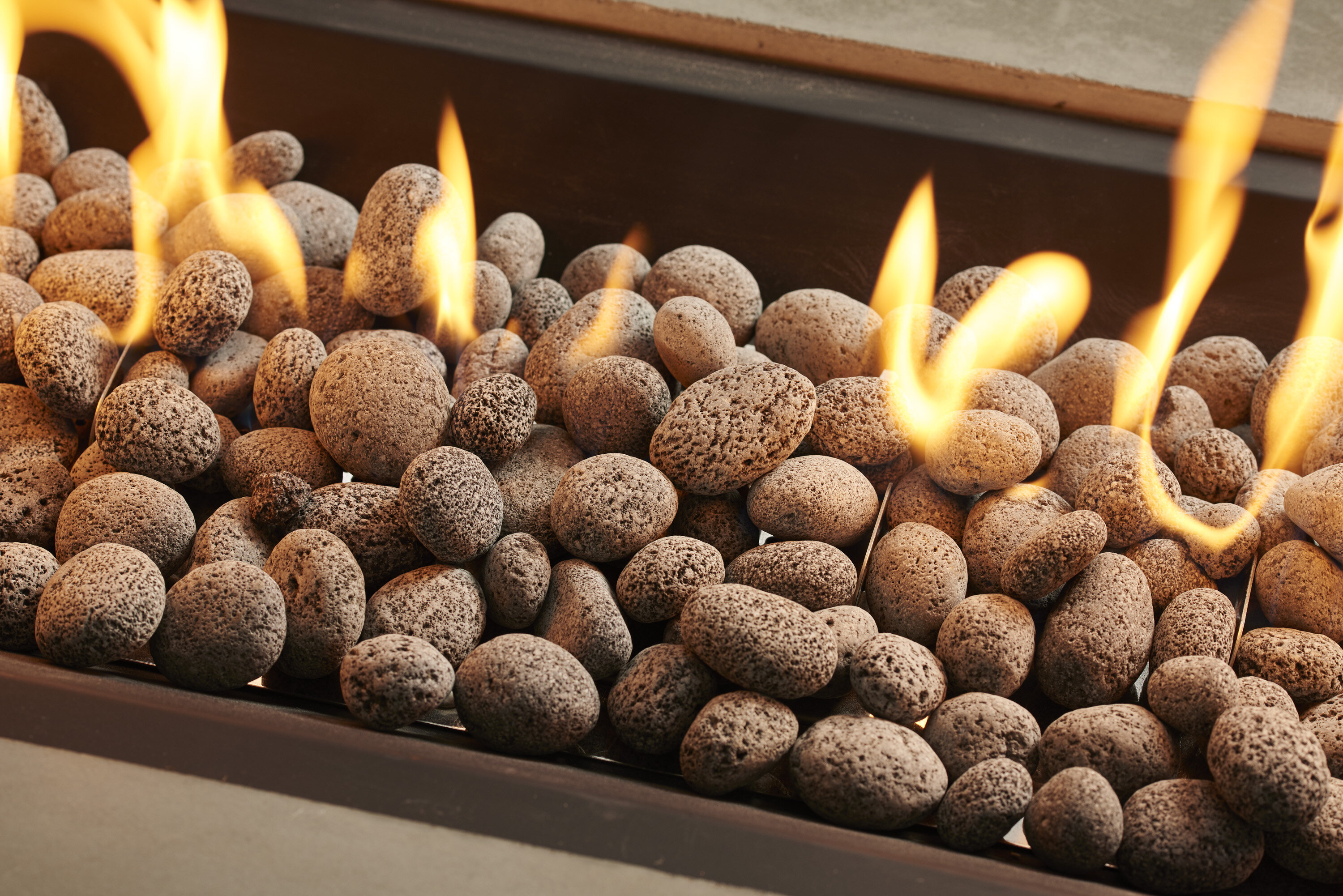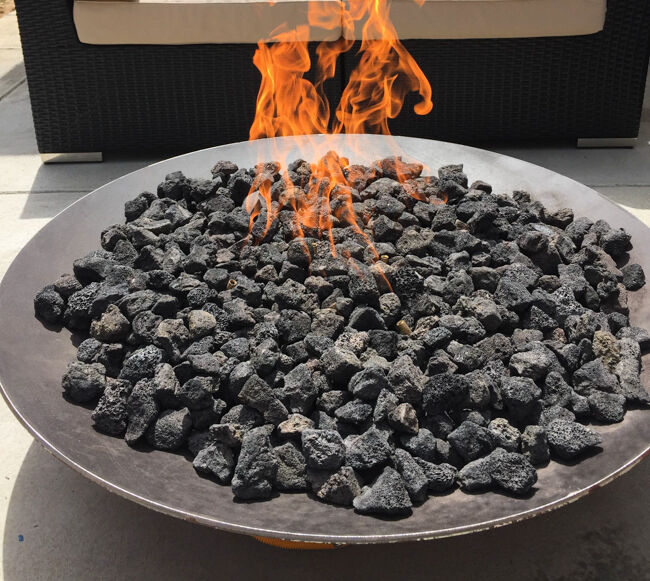Call us at 725-239-9966!
M-F: 8 AM-7 PM PST
Call us at 725-239-9966!
M-F: 8 AM-7 PM PST

Arranging lava rocks around your outdoor fire pit creates an incredibly inviting backyard paradise. The dancing flames reflect beautifully off the colorful volcanic stones, transforming any ordinary space into a warm, cozy gathering area for family and friends.
But arranging the lava rocks isn't that easy. You have to consider factors like airflow, heat distribution, desired appearance, and creativity in design to customize the look. Follow these simple tips to arrange the lava rocks with ease.

Before you begin arranging, make sure you have the necessary supplies and take safety precautions. Proper setup is crucial when incorporating lava rocks into a gas fire pit. Refer to our fire pit buyer's guide to learn about the essential components and features.
Other key equipment needed includes:
Proper preparation is a must before placing lava rocks. Follow these simple steps:
If replacing existing lava rocks, empty out the old materials. Use a soft brush to gently clean the fire pit floor and side walls. This removes soot and debris that could impede ventilation.
Examine the propane or natural gas burner, igniter, tubing, and connections. Look for any leaks, breaks, blockages, or corrosion. Fix any issues prior to replacing the lava rocks.
With so many options on the market, deciding on the best lava rocks for your gas fire pit may seem confusing. Keep these considerations in mind when selecting:
The two most readily available types of lava rock include basalt and andesite. Both are generated from volcanic eruptions.
Basalt - This very dark charcoal-colored rock comes from lava with a lower viscosity that spreads more easily over land. It has a smooth, fine-grained texture.
Andesite - Often found in shades of dark gray or brown, andesite emerges from thicker lava with higher silica content. It is slightly more coarse and porous than basalt.
Both types work well in gas fire pits, but andesite lava rocks tend to cost a little less while providing better heat properties.
Lava rock sizes generally range from 1⁄4 inch pieces up to 6 inches in diameter or larger. The dimensions you choose will impact:
Appearance - Smaller lava rocks like pea gravel offer a neater, more uniform look. Larger rocks create rustic textures and contours. Using a blend provides visual variety.
Air Circulation – You’ll need an adequately sized drainage layer between rocks for proper airflow to your fire pit’s burner system. Too little space can starve the oxygen supply.
Heat Distribution – Varied lava rock sizes allow both large and small pieces to transmit warmth effectively. Larger bottom rocks store heat, while smaller top rocks spread it around.
Use this chart as a guideline when choosing lava rock sizes for your specific fire pit:
| Fire Pit Dimension | Recommended Lava Rock Size |
|---|---|
| Small (< 3 ft diameter) | 1⁄4 - 1 inch pieces |
| Standard (3 - 5 ft diameter) | 1 - 3 inch pieces |
| Large (> 5 ft diameter) | 3 - 6 inch pieces |
Use this formula to determine how much lava rock you need to purchase:
Diameter X Diameter X Depth, divided by 24 = pounds of lava rock needed.
There are also online fire pit rock calculators that perform these calculations automatically after inputting dimensions.
Buying extra is wise since having too little lava rock can look sparse and uneven. The leftover stone works wonderfully along pathways, gardens, and retaining walls.

Skillfully arranging lava rocks transforms a basic gas fire pit into an inviting backyard paradise that sparks conversation. Follow these tips for eye-catching results:
Clean out old debris inside the fire pit using a small shovel or garden trowel. Check components for damage needing repair.
Cover the fire pit floor with a 1-inch layer of crushed gravel or sand for drainage. Smooth to level.
Position the largest lava rocks around the outer edges first, then increasingly smaller ones toward the center.
Allow a 2-3 inch gap between rocks for ample airflow to the gas fire pit burner.
Top dress the center with pea gravel or small pieces last to finish a smooth surface and fill gaps.
Ignite the fire pit burner system according to its instructions once lava rocks are placed. Enjoy!
When arranging lava rocks in your modern outdoor fire pit, get creative with the positioning to create stunning designs. Consider incorporating some of these unique arrangement ideas:
For a polished look, arrange your lava rocks in concentric circles emanating from the center of the fire pit.
Start by placing the largest lava rocks around the outermost part of the fire pit, about 6 inches from the edge to create a layer of lava rocks. Make sure the rocks stand on their edges for stability.
Build another ring using slightly smaller lava rocks, nesting it inside the first ring. Leave about 3 inches of space between the two rock rings.
Continue building additional rings moving inward, using gradually smaller lava rocks as you go.
At the center, stack a mound of pea gravel or small lava pebbles around the burner element.
The result is a neat, rounded pattern reminiscent of ripples in a pond. The varying lava rock sizes add multidimensional appeal.
For a modern, structured look, arrange your lava rocks to form geometric shapes:
Select lava rocks with flattened surfaces that can stand upright. Position the first few rocks in an upright diamond or square formation around the burner element.
Continue placing upright lava rocks, using small pebbles to fill gaps. Expand the pattern outward to cover the fire pit floor.
If desired, delineate the lines of the geometry by alternating black and red lava rocks for a striking contrast.
The resulting crisscross or zig-zag designs inject some contemporary style into your fire pit.
Think outside the box by using lava rocks to build unique 3D structures:
Pile medium-sized lava stones to form mini volcano-shaped mounds, leaving space between each one.
Use larger lava rocks to create arched bridges, propped-up towers, or abstract sculptures as accents.
Arrange horizontal walls of flat-shaped lava rocks to divide zones within the fire pit.
Let your creativity run wild! Combine shapes and sizes to design one-of-a-kind decorations for your fire pit with lava.

Lava rocks are incredibly durable and long-lasting. However, over years of exposure to weather fluctuations and extreme heat, they can start deteriorating.
Signs that lava rocks need replacing include the following:
Ideally, replacing lava rocks every 1-2 years ensures optimal condition. Budgeting for new lava rock and fire pit component upgrades periodically saves money over constantly repairing damage later on.
Skillfully arranging smooth lava rocks around the deep perimeter of your inviting fire pit creates a welcoming focal point in any backyard. The natural-looking stones withstand extremely high temperatures, retain heat effectively, and provide exceptional drainage. Their understated earthy hues beautifully reflect flickering flames for memorable nights outdoors.
For stunning effects, try stacking distinctive lava rock shapes or inserting colorful fire glass. Budgeting periodic upgrades maintains optimal conditions so everyone can enjoy cozy gatherings for years. Properly placing these hearty volcanic stones around your gorgeous gas fire pit crafts an alluring, must-see backyard paradise.
Yes, different colors of lava rocks such as black lava rocks and red can provide visual appeal to your fire pit. However, be sure they are safe to use in a fire pit before making your choice.
If you are not keen to use lava rock on your gas propane fire pit, alternatives like fire glass beads or fire pit stones can be used. Fire glass also creates a beautiful effect when it catches the light from the fire.
Lava rock enhances the effect of your gas fire pit by improving heat distribution and creating a realistic and natural look. It doesn't burn or discolor, making it an excellent choice for fire pits.
To maximize efficiency, ensure the lava rocks are evenly distributed across the surface of the fire pit. Also, stacking larger rocks at the base and smaller ones on top can create better airflow. The size of your fire pit can also affect how you arrange the lava rocks.
Cleaning lava rocks from a gas fire pit typically involves removing the rocks, washing them with a mixture of water and vinegar, and then rinsing them off. Once they're dry, you can put them back into the fire pit.
Yes, you can create a fire pit with only lava rocks. These rocks are great for a backyard fire pit because they’re heat-resistant and look natural. However, aside from lava rocks, other elements like a fire ring or burner system would also be needed to create a functioning fire pit.

{"one"=>"Select 2 or 3 items to compare", "other"=>"{{ count }} of 3 items selected"}
Leave a comment